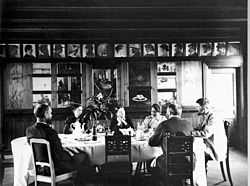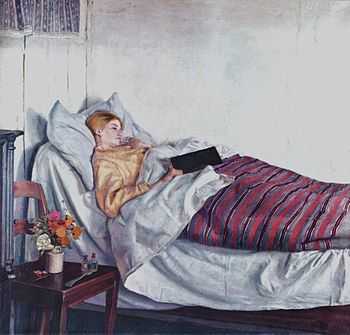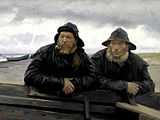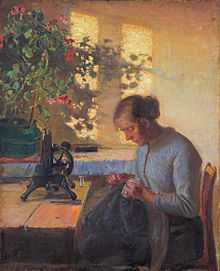Skagen Painters

The Skagen Painters were a group of Scandinavian artists who gathered in the area of Skagen, the northernmost part of Denmark, from the late 1870s until the turn of the century. Skagen was a summer destination whose scenery and quality of light attracted northern artists to paint en plein air following the French Impressionists—though members of the Skagen collective were also influenced by realist movements such as the Barbizon school. They broke away from the rather rigid traditions of the Royal Danish Academy of Fine Arts and the Royal Swedish Academy of Arts, espousing the latest trends they had learnt in Paris.[1]
Skagen, in the very north of Jutland, was the largest fishing community in Denmark, with more than half of its population so engaged. Among the locals, fishermen were by far the most common subject for the Skagen painters.[2] Skagen's long beaches were exploited in the group's landscapes; Peder Severin Krøyer, one of the best-known of the Skagen painters, was inspired by the light of the evening "Blue Hour", which made the water and sky seem to optically merge. This is captured in one of his most famous paintings, Summer Evening at Skagen Beach – The Artist and his Wife.
Members of the group
The group included Swedish painters Oscar Björck and Johan Krouthén, Norwegian painters Christian Krohg and Eilif Peterssen, Danish painters Karl Madsen, Laurits Tuxen, Marie Krøyer, Carl Locher, Viggo Johansen, Thorvald Niss, and most notably, Anna and Michael Ancher and Peder Severin Krøyer. The gatherings in Skagen were not restricted to painters. Danish writers Georg Brandes, Holger Drachmann and Henrik Pontoppidan and Swedish composer Hugo Alfvén were also members of the group. [3]
A number of other artists also joined the Skagen Painters for shorter periods. From Denmark they included Vilhelm Kyhn, Einar Hein and Frederik Lange, from Norway Frits Thaulow, Charles Lundh and Wilhelm Peters, from Sweden Wilhelm von Gegerfelt and Anna Palm de Rosa, from Germany Fritz Stoltenberg and Julius Runge, and from England Adrian Stokes and his Austrian-born wife, Marianne Stokes. The Danish composer Carl Nielsen and his wife Anne Marie, a sculptor, also spent summers in Skagen and eventually bought a summerhouse there.[1][4]

History

The first notable artist to paint in Skagen was Martinus Rørbye (1803–1848), one of the central figures of the Golden Age of Danish Painting. His first visit was in 1833 but he returned towards the end of his life in 1847 and 1848. He is remembered in particular for his Men of Skagen on a summer evening in fair weather painted in 1848.[5] Another marine painter, Vilhelm Melbye (1824–1822), visited Skagen in 1848 contributing his View over Skagen.[6] According to Karl Madsen, the history painter Peter Raadsig (1806–1882) also visited Skagen on several occasions between 1862 and 1870, painting the dunes and the fishermen.[7] Christian Blache (1838–1920), another marine painter, first visited Skagen in 1869 when he painted his Skagens grå fyr. It was as a result of his influence that Holger Drachmann first visited the town in 1871.[7]
From 1871, Michael Ancher studied at the Royal Danish Academy of Fine Arts in Copenhagen together with Karl Madsen and Viggo Johansen. In 1874, he went to Skagen to paint the local fishermen and became a friend of the Brøndum family who had a shop with a bar which was soon extended to become Brøndums Gastgiveri, a guest house. He was invited to their 15-year-old daughter Anna's confirmation and showed an immediate interest in her. The following year, he returned to Skagen together with Madsen and Johansen who had been strongly influenced by French impressionism. In particular, Johansen began to paint open-air scenes combining impressionism with realism.[3]
In 1876 and especially in 1877, several other artists came to spend the summer in Skagen, using the Brøndum's house as a residence and centre for their gatherings. Michael Ancher made Skagen his new home, became engaged to Anna Brøndum in 1878 and married her in 1880. Their home then became the centre of attraction for the artists, especially after King Christian IX bought Ancher's painting Will he round the point?.[8]
Anna Ancher first took a serious interest in painting after the artists began to stay in the family's hotel, leaving their paintings to dry in their rooms when they left for the day. She studied them carefully and in 1875 attended Vilhelm Kyhn's art school in Copenhagen. She was later influenced by Christian Krohg who taught her the art of painting people in their everyday lives and making full use of colour.[9]
Christian Krohg first came to Skagen in the summer of 1878, encouraged by Georg Brandes whom he had met in Berlin. He brought many of the latest international art trends with him, influencing the other members of the group. His encounters with the local population also exerted a strong influence on his own work.[10]
In 1882, the Anchers travelled abroad. While they were in Vienna, they met P. S. Krøyer who informed them he would also be going to Skagen that year, despite the fact that Ancher was apparently not too keen to have him therem. Krøyer, who had enjoyed close contacts with several impressionist artists in Paris, immediately became the central member and unofficial leader of the artists' colony. In 1883, he created the "Evening Academy" where the artists gathered to paint and discuss each other's work, often enjoying themselves with wine and champagne.[11] In 1884, the German painter Fritz Stoltenberg took photographs of the artists celebrating in the Anchers' garden, just after the couple had moved into their new home. One of these photos in particular inspired Krøyer to paint Hip, Hip, Hurrah! which he did not complete for another four years.[12][3]
In 1890, the railway to Skagen not only led to the expansion of the village but also brought in considerable numbers of tourists. It was largely responsible for breaking up the regular summer meetings of the artists' colony as they could no longer find suitable accommodation and venues for their meetings. However, some of them purchased homes in Skagen: P. S. Krøyer in 1894, Laurits Tuxen in 1901, Holger Drachmann in 1903.[13]
Anna and Michael Ancher, Krøyer and Tuxen continued to paint in Skagen until well into the 20th century and were occasionally joined by their earlier friends. Two core members of the group, Holger Drachmann and P. S. Krøyer, died in 1908 and 1909, bringing the traditional gatherings of the group to an end. There were nevertheless other painters, sometimes referred to as the younger group of Skagen painters, who continued to visit the area. They included Jørgen Aabye, Tupsy and Gad Frederik Clement, Ella Heide, Ludvig Karsten, Frederik Lange and Johannes Wilhjelm, some of whom settled in the area until the 1930s or even later. Skagens Museum has a number of their works in its collection.[14] Another notable artist who visited Skagen from 1906 was J.F. Willumsen who completed his painting Badende børn på Skagen strand (Children bathing on Skagen beach) in 1909..[15]
Family relationships

The Skagen painters quickly began to form a close-knit community as relationships grew between the artists and the young women from the area. In 1880, Michael Ancher married Anna Brøndum from the guest house, Viggo Johansen married Martha Møller, Anna's cousin, and Karl Madsen married Helene Christensen, a schoolteacher. The house the Anchers moved into in 1884 became a focus for the artists' colony, especially as the couple lived there all the year round. When their daughter Helga (the little girl in Hip, hip, hurrah!) died in 1964, she left the house to a foundation which soon turned it into a museum.[16]
The Johansens acquired a large family between 1881 and 1886: Ellen Henriette (daughter of Henriette, Martha's sister, who died during childbirth), Lars, Fritz, Gerda and Bodil. They can be seen dancing around the Christmas tree in Johansen's painting Merry Christmas.
Another key figure in Skagen, P. S. Krøyer, married Marie Triepcke after falling in love with her in Paris in 1888. The daughter of a prosperous German loomery engineer, she was said to be the most beautiful women in Denmark. However, as the years went by, Krøyer's health began to deteriorate and Marie was increasingly unhappy with their marriage. The marriage finally ended in a divorce in 1905 when Marie became pregnant after an affair with Swedish composer Hugo Alfvén whom she then married. Krøyer died in Skagen four years later, apparently as a result of mental illness.[1]
In 1901, after the death of his first wife Ursule, Laurits Tuxen married Frederikke Treschow, a Norwegian, and shortly afterwards purchased Madam Bendsen's house in Skagen where first Viggo and Martha Johansen and later Marie og P. S. Krøyer had stayed in the 1880s. He converted it into a stately summer residence.[17]
Michael Ancher and Laurits Tuxen died in 1927, Anna Ancher and Viggo Johansen in 1935.
Skagen's Museum

Skagen's Museum was founded in the dining room at Brøndum’s Hotel during October 1908. Victor Christian Klæbel, the local pharmacist, Degn Brøndum, proprietor of Brøndum's Hotel and Anna Ancher's brother, and artists Michael Ancher, P. S. Krøyer and Laurits Tuxen, were elected to form the first board of governors. After P. S. Krøyer’s death in 1909, his house in Skagen Plantation was used as a museum. In 1919, Degn Brøndum donated the old hotel’s garden to Skagens Museum. Work started in 1926 and was completed in September 1928 when the new museum was officially opened.[18]
In 1982, the exhibition rooms were extended with an annex drafted by the Royal Surveyor, architect Jacob Blegvad, who also designed the later extension to the museum inaugurated in 1989. In 1997, the museum administration moved into the Technical School. Today Skagen's Museum has more than 1,800 works of art.[19] Many of the museum's paintings have been digitized under the Google Art Project and are accessible on line.[20]
Films
The Skagen artists were the subject of the 1987 film Hip Hip Hurra! by Swedish director Kjell Grede, after the painting with the same name by Krøyer.[21]
In 2012, the film The Passion of Marie, directed by Bille August, covered Marie's increasingly difficult relationship with her husband P. S. Krøyer. The film is based on the book Balladen om Marie by Anastassia Arnold.[22][23]
Gallery of paintings
The gallery below presents a number of paintings by the Skagen artists, roughly in chronological order.
-

Portside, Christian Krohg, 1879
-

Will he round the point?, Michael Ancher, ca. 1880
-

The Sick Girl, Michael Ancher, 1882
-

Artists' Luncheon at Skagen, P. S. Krøyer, 1883
-

Oscar Björck, Signal of Distress (1883)
-

Sleeping Boy, Johan Krouthén, 1883
-

Båden sættes i søen, Oscar Björck, 1885
-

Et l'hombre-parti, Anna Palm de Rosa, 1885
-
.jpg)
A Christening, Michael Ancher, 1888
-

Two Fishermen, Michael Ancher, 1889
-

Skagen fisherman, Michael Ancher
-

Sewing fisherman's wife, Anna Ancher, 1890
-

Sunlight in the blue room, Anna Ancher, 1891
-

Summer Evening on the Skagen Southern Beach, P. S. Krøyer, 1893
-

The Beach of Skagen, Thorvald Niss, ca. 1989
-

Self-portrait, P. S. Krøyer, 1897
-

Summer evening on Skagen's beach, P. S. Krøyer, 1899
-
_1905.jpeg)
Interior with poppies and reading woman (Lizzy Hohlenberg), Anna Ancher, 1905
-

Midsummer's Eve Bonfire on Skagen's Beach, P. S. Krøyer, 1906
-

Boats on Sønderstrand in Skagen, Viggo Johansen, 1910
See also
- Art of Denmark
- Bornholm school of painters
Notes
- ↑ 1.0 1.1 1.2 Lise Svanholm, "Malerne på Skagen", (Danish), Gyldendal 2001, pp 30–43, ISBN 87-00-75184-7.
- ↑ pp. 55–56 in Nina Lübbren (2001). Rural artists' colonies in Europe, 1870–1910. Barber Institute's critical perspectives in art history series. Manchester University Press. ISBN 0-7190-5867-8
- ↑ 3.0 3.1 3.2 Vibeke Sandby, Pernille and Jens Agerholm, "Skagens trofaste veninde", Agenholm, 2000. (Danish) ISBN 87-987939-1-8
- ↑ "Family life", Carl Nielsen Society. Retrieved 29 August 2010.
- ↑ "Martinus Rørbye", Kunstindekx Danmark & Weilbachs Kunstnerleksikon. (Danish) Retrieved 1 November 2013.
- ↑ "Vilhelm Melbye", Den Store Danske. (Danish) Retrieved 1 November 2013.
- ↑ 7.0 7.1 Svanholm, Lise (2003). Skagenleksikon: malerne, modellerne, værkerne og stederne. Gyldendal A/S. pp. 27–. ISBN 978-87-02-01947-6.
- ↑ "Michael Ancher: Vil han klare pynten? – Ca. 1880", Skagens Museum. (Danish) Retrieved 15 October 2013.
- ↑ Elisabeth Fabritius, "Anna Ancher", Dansk Kvindebiografisk Leksiko n. (Danish) Retrieved 25 July 2010.
- ↑ "Christian Krohg og Skagen", Skagens Museum. (Danish) Retrieved 25 July 2010.
- ↑ Alba Schwartz, "Skagen – Den nye Tid i Oplevelser og Indtryk", Skagens Museum, 1992, pp 117–120. ISBN 978-87-983631-1-8
- ↑ "Hip, Hip, Hurray!", Skagens Museum. Retrieved 15 October 2013.
- ↑ Mona Jensen (editor), "Danske kunstnerkolonier. Skagen. Fyn. Bornholm", Aarhus Kunstmuseums Forlag, 2000.
- ↑ "Skagens Museum: Insamling", Kulturarv.dk. (Danish) Retrieved 29 October 2013.
- ↑ "J.F. Willumsen: Badende børn på Skagen strand. 1909", Skagens Museum. (Danish) Retrieved 11 November 2013.
- ↑ "Michael og Anna Anchers Hus / Saxilds Gaard". (Danish) Anchershus.dk. (Danish) Retrieved 15 October 2013.
- ↑ "Madam Bendsens gård", Skagen i gamle dage. (Danish) Retrieved 27 August 2010.
- ↑ "Museets historie" (in Danish). Skagens Museum. Retrieved 2013-10-25.
- ↑ "Skagens Museum", Retrieved 19 August 2010.
- ↑ "Skagens Museum", Google Art Project. Retrieved 7 August 2013.
- ↑ "Hip Hip Hurrah!", IMDb. Retrieved 15 October 2013.
- ↑ "Marie Krøyer", Kino.dk. (Danish) Retrieved 15 October 2013.
- ↑ Arnold, Anastassia (2010). Balladen om Marie: en biografi om Marie Krøyer. Rosinante. ISBN 978-87-638-1229-0.
Further reading
- Arnold, Anastassia (2010). Balladen om Marie: en biografi om Marie Krøyer. Rosinante. ISBN 978-87-638-1229-0. (Danish)
- Bøgh Jensen, Mette (2011). Brøndums spisesal: Til tak for glade dage. Skagens Museum. ISBN 978-87-91048-26-5. (Danish)
- Houkjær, Christian (1964). Liv og kunst i Skagen: Anna og Michael Ancher blandt deres modeller. J. Frimodt. (Danish)
- Jensen, Mona (2000). Danske kunstnerkolonier: Skagen, Fyn, Bornholm. Aarhus Kunstmuseums Forlag. ISBN 978-87-88575-41-5. (Danish)
- Schwartz, Walter (1952). Skagen i nordisk kunst: fra Michael Ancher til Ludvig Karsten. C. Andersen. (Danish)
- Stensgaard, Pernille (2004). Skagen. Gyldendal A/S. ISBN 978-87-02-02089-2. (Danish)
- Svanholm, Lise (2006). Damerne på Skagen. Gyldendal A/S. ISBN 978-87-02-04499-7. (Danish)
- Svanholm, Lise (2004). Northern Light: The Skagen Painters. Gyldendal A/S. ISBN 978-87-02-02817-1.
External links
| Wikimedia Commons has media related to Skagen Painters. |
| |||||||||||||||||||
| |||||||||||||||||